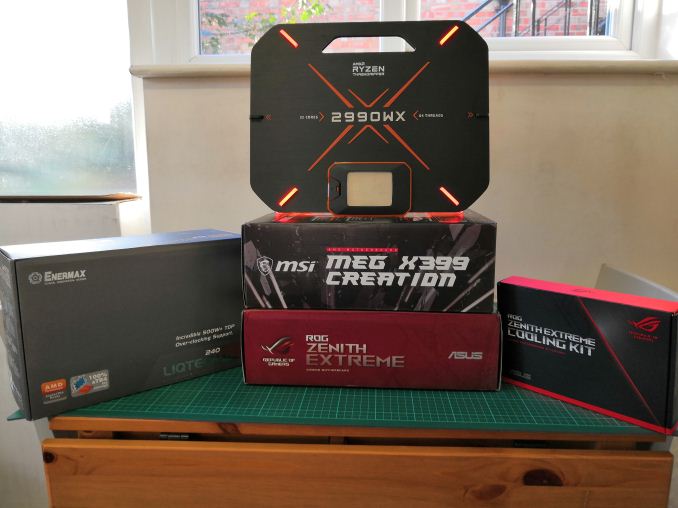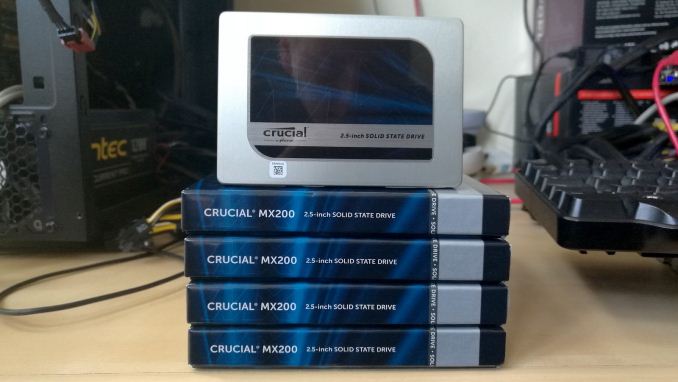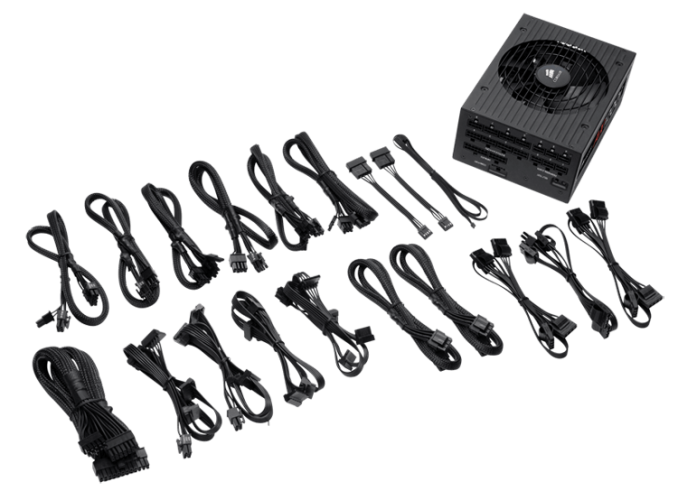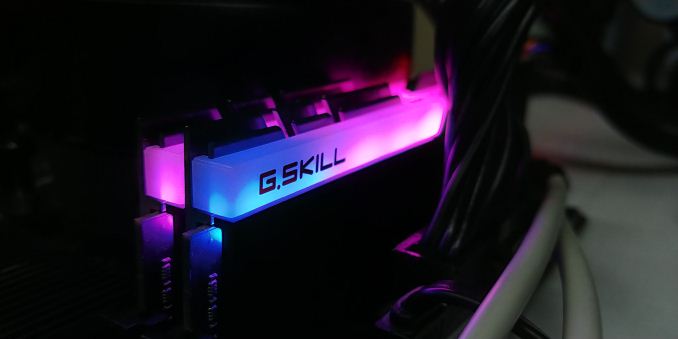The AMD Threadripper 2990WX 32-Core and 2950X 16-Core Review
by Dr. Ian Cutress on August 13, 2018 9:00 AM ESTTest Setup and Comparison Points
In our review kit from AMD, we were supplied with almost complete systems for testing. Inside the box of goods, AMD included:
- AMD Threadripper 2990WX (32C, 250W, $1799)
- AMD Threadripper 2950X (16C, 180W, $899)
- ASUS ROG Zenith Extreme motherboard, rev 2
- MSI X399 MEG Creation motherboard
- 4x8 GB of G.Skill FlareX DDR4-3200 14-14-14
- Wraith Ripper Cooler, co-developed with Cooler Master
- Enermax Liqtech 240 TR4 Liquid Cooler, rated to 500W
For our usual testing, we stick to the same power supplies, the same storage, ideally the same motherboard within a range of processors, and always use the latest BIOS. Despite AMD shipping us some reasonably fast memory, our standard policy is to test these systems at the maximum supported frequency as promoted by the processor manufacturer, or in this case DDR4-2933 for the new Threadripper 2000-series processors.
For our testing we compared the first generation Threadripper processors with the second generation parts. We also have the Intel 18-core Core i9-7980XE, some results from the Core i7-7900X (10-core), and also two mainstream processors, one Intel and one AMD. This is due to our new CPU testing suite, which takes effect today.
Due to an industry event occuring in the middle of our testing, we had to split some of the testing up and take 30 kg of kit half-way around the world to test in a hotel room during Flash Memory Summit. On the downside, it means there is some discontinuity in our testing, although not that much - on the plus side, the hardware tested in the hotel room had a good amount of air-conditioning to keep cool.
| AMD Test Setup | |||||
| CPUs | TR 2990WX | ASUS ROG Zenith | 0078 | Liqtech TR4 | 4x8GB DDR4-2933 |
| TR 2950X | ASUS ROG Zenith | 0078 | Liqtech TR4 | 4x8GB DDR4-2933 | |
| TR 1950X | ASUS X399-A Prime | 0806 | TRUE Cu | 4x4GB DDR4-2666 | |
| TR 1920X | ASUS ROG Zenith | 0078 | Liqtech TR4 | 4x8GB DDR4-2666 | |
| TR 1900X | ASUS X399-A Prime | 0806 | TRUE Cu | 4x4GB DDR4-2666 | |
| R7 2700X | ASUS Crosshair VI Hero | 0508 | Wraith Max | 4x8GB DDR4-2933 | |
| EPYC 7601 | GIGABYTE MZ31-AR0 | Fryzen | 8x128GB DDR4-2666 | ||
| GPU | Sapphire RX 460 2GB (CPU Tests) | ||||
| PSU | Corsair AX860i Corsair AX1200i |
||||
| SSD | Crucial MX300 1TB | ||||
| OS | Windows 10 x64 RS3 1709 Spectre and Meltdown Patched |
||||
The memory for our test suites was mostly G.Skill, with some Crucial. For the EPYC system, Micron sent us some LRDIMMs, so we fired up 1TB of memory to get all eight channels working.
On the Intel side, we are still getting up to speed on our testing.
| Intel Test Setup | |||||
| CPUs | i9-7980XE | ASRock X299 OC Formula | P1.40 | TRUE Cu | 4x8GB DDR4-2666 |
| i9-7900X | ASRock X299 OC Formula | P1.40 | TRUE Cu | 4x8GB DDR4-2666 | |
| i7-8700K | ASRock Z370 Gaming i7 | P1.70 | AR10-115XS | 4x4GB DDR4-2666 | |
| GPU | Sapphire RX 460 2GB (CPU Tests) | ||||
| PSU | Corsair AX860i Corsair AX1200i |
||||
| SSD | Crucial MX300 1TB | ||||
| OS | Windows 10 x64 RS3 1709 Spectre and Meltdown Patched |
||||
Over time we will be adding to our Intel CPUs tested.
Many thanks to...
We must thank the following companies for kindly providing hardware for our multiple test beds. Some of this hardware is not in this test bed specifically, but is used in other testing.
Thank you to Crucial for providing us with MX200 SSDs and to Micron for LRDIMMs. Crucial stepped up to the plate as our benchmark list grows larger with newer benchmarks and titles, and the 1TB MX200 units are strong performers. Based on Marvell's 88SS9189 controller and using Micron's 16nm 128Gbit MLC flash, these are 7mm high, 2.5-inch drives rated for 100K random read IOPs and 555/500 MB/s sequential read and write speeds. The 1TB models we are using here support TCG Opal 2.0 and IEEE-1667 (eDrive) encryption and have a 320TB rated endurance with a three-year warranty.
Further Reading: AnandTech's Crucial MX200 (250 GB, 500 GB & 1TB) Review
Thank you to Corsair for providing us with an AX1200i PSU. The AX1200i was the first power supply to offer digital control and management via Corsair's Link system, but under the hood it commands a 1200W rating at 50C with 80 PLUS Platinum certification. This allows for a minimum 89-92% efficiency at 115V and 90-94% at 230V. The AX1200i is completely modular, running the larger 200mm design, with a dual ball bearing 140mm fan to assist high-performance use. The AX1200i is designed to be a workhorse, with up to 8 PCIe connectors for suitable four-way GPU setups. The AX1200i also comes with a Zero RPM mode for the fan, which due to the design allows the fan to be switched off when the power supply is under 30% load.
Further Reading: AnandTech's Corsair AX1500i Power Supply Review
Thank you to G.Skill for providing us with memory. G.Skill has been a long-time supporter of AnandTech over the years, for testing beyond our CPU and motherboard memory reviews. We've reported on their high capacity and high-frequency kits, and every year at Computex G.Skill holds a world overclocking tournament with liquid nitrogen right on the show floor.
Further Reading: AnandTech's Memory Scaling on Haswell Review, with G.Skill DDR3-3000














171 Comments
View All Comments
ibnmadhi - Monday, August 13, 2018 - link
It's over, Intel is finished.milkod2001 - Monday, August 13, 2018 - link
Unfortunately not even close. Intel was dominating for last decade or so. Now when AMD is back in game, many will consider AMD but most will still get Intel instead. Damage was done.It took forever to AMD to recover from being useless and will take at least 5 years till it will get some serious market share. Better late than never though...tipoo - Monday, August 13, 2018 - link
It's not imminent, but Intel sure seems set for a gradual decline. It's hard to eke out IPC wins these days so it'll be hard to shake AMD off per-core, they no longer have a massive process lead to lead on core count with their margins either, and ARM is also chipping away at the bottom.Intel will probably be a vampire that lives another hundred years, but it'll go from the 900lb gorilla to one on a decent diet.
ACE76 - Monday, August 13, 2018 - link
AMD retail sales are equal to Intel now...and they are starting to make a noticeable dent in the server market as well...it won't take 5 years for them to be on top...if Ryzen 2 delivers a 25% increase in performance, they will topple Intel in 2019/2020HStewart - Monday, August 13, 2018 - link
"AMD retail sales are equal to Intel now"Desktop maybe - but that is minimal market.
monglerbongler - Monday, August 13, 2018 - link
Pretty much this.No one really cares about workstation/prosumer/gaming PC market. Its almost certainly the smallest measurable segment of the industry.
As far as these companies' business models are concerned:
Data center/server/cluster > OEM consumer (dell, hp, microsoft, apple, asus, toshiba, etc.) > random categories like industrial or compact PCs used in hospitals and places like that > Workstation/prosumer/gaming
AMD's entire strategy is to desperately push as hard as they can into the bulwark of Intel's cloud/server/data center dominance.
Though, to be completely honest, for that segment they really only offer pure core count and PCIe as benefits. Sure they have lots of memory channels, but server/data center and cluster are already moving toward the future of storage/memory fusion (eg Optane), so that entire traditional design may start to change radically soon.
All important: Performance per unit of area inside of a box, and performance per watt? Not the greatest.
That is exceptionally important for small companies that buy cooling from the power grid (air conditioning). If you are a big company in Washington and buy your cooling via river water, you might have to invest in upgrades to your cooling system.
Beyond all that the Epyc chips are so freaking massive that they can literally restrict the ability to design 2 slot server configuration motherboards that also have to house additional compute hardware (eg GPGPU or FPGA boards). I laugh at the prospect of a 4 slot epyc motherboard. The thing will be the size of a goddamn desk. Literally a "desktop" sized motherboard.
If you cant figure it out, its obvious:
Everything except for the last category involves massive years-spanning contracts for massive orders of hundreds of thousands or millions of individual components.
You can't bet hundreds of millions or billions in R&D, plus the years-spanning billion dollar contracts with Global Foundries (AMD) or the tooling required to upgrade and maintain equipment (Intel) on the vagaries of consumers, small businesses that make workstations to order, that small fraction of people who buy workstations from OEMs, etc.
Even if you go to a place like Pixar studios or a game developer, most of the actual physical computers inside are regular, bone standard, consumer-level hardware PCs, not workstation level equipment. There certainly ARE workstations, but they are a minority of the capital equipment inside such places.
Ultimately that is why, despite all the press, despite sending out expensive test samples to Anandtech, despite flashy powerpoint presentations given by arbitrary VPs of engineering or CEOs, all of the workstation/Prosumer/gaming stuff is just low-binned server equipment.
because those are really the only 2 categories of products they make;
pure consumer, pure workstation. Everything else is just partially enabled/disabled variations on those 2 flavors.
Icehawk - Monday, August 13, 2018 - link
I was looking at some new boxes for work and our main vendors offer little if anything AMD either for server roles or desktop. Even if they did it's an uphill battle to push a "2nd tier" vendor (AMD is not but are perceived that way by some) to management.PixyMisa - Tuesday, August 14, 2018 - link
There aren't any 4-socket EPYC servers because the interconnect only allows for two sockets. The fact that it might be difficult to build such servers is irrelevant because it's impossible.leexgx - Thursday, August 16, 2018 - link
is more then 2 sockets needed when you have so many cores to play withRelic74 - Wednesday, August 29, 2018 - link
Actually there are, kind of, supermicro for example has created a 4 node server for the Epyc. Basically it's 4 computers in one server case but the performance is equal to that if not better than that of a hardware 4 socket server. Cool stuff, you should check it out. In fact, I think this is the way of the future and multi socket systems are on their way out as this solution provides more control over what CPU. As well as what the individual cores are doing and provides better power management as you can shut down individual nodes or put them in stand by where as server with 4 sockets/CPU's is basically always on.There is a really great white paper on the subject that came out of AMD, where the stated that they looked into creating a 4 socket CPU and motherboard capable of handling all of the PCI lanes needed, however it didn't make any sense for them to do so as there weren't any performance gains over the node solution.
In fact I believe we will see a resurrection of blade systems using AMD CPU's, especially now with all of the improvements that have been made with multi node cluster computing over the last few years.